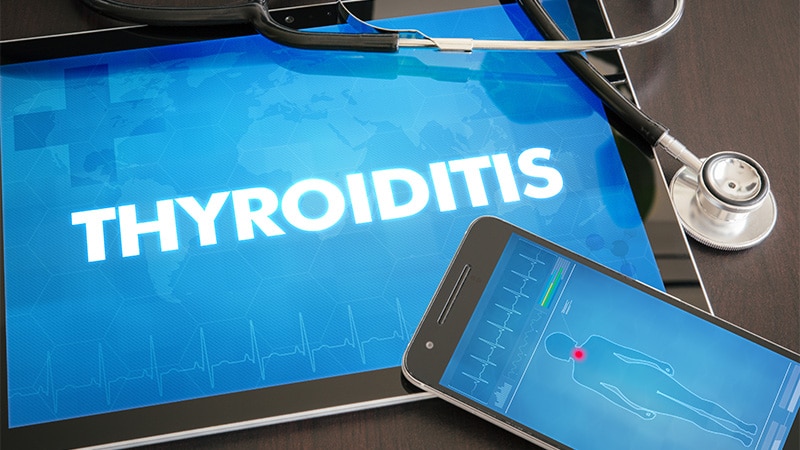The study covered in this summary was published on researchsquare.com as a preprint and has not yet been peer reviewed.
Key Takeaway
-
The results showed that a low-dose prednisolone regimen was noninferior to a regular-dose regimen for treating people with subacute thyroiditis in a prospective, single-center, randomized study that was completed by 36 patients.
Why This Matters
-
The 2016 American Thyroid Association guidelines recommend prednisone for treating moderate to severe subacute thyroiditis at a starting dose of 40 mg/day, with gradual tapering down over 2–4 weeks on the basis of clinical response. However, there is relatively little evidence to support this regimen, the authors said.
-
In China, the recommended starting dose is 30 mg/day. Patients often terminate treatment or reduce the dosage on their own because of side effects of high-dose prednisolone, potentially blunting the treatment effect.
-
Results of the current study showed that the efficacy of oral prenisolone, beginning with a lower dose of 15 mg/day, was noninferior to a regular dose beginning at 30 mg/day. The finding suggests that low-dose therapy may be sufficient for achieving complete recovery from subacute thyroiditis.
Study Design
-
The prospective, randomized, open-label, single-center, parallel-group, controlled, noninferiority study was conducted at Yijishan Hospital in Wuhu, China, from December 2020 to December 2021.
-
The researchers randomly assigned 40 adults with subacute thyroiditis to receive either low-dose prednisolone,starting at 15 mg/day for 1 week followed by weekly tapering decrements to daily doses of 10 mg, 5 mg, and 2.5 mg; or to regular-dose prednisolone starting at 30 mg/day for the first week followed by tapering decrements to daily doses of 15 mg, 10 mg, 5 mg, and 2.5 mg.
-
Thirty-six of the enrolled patients completed the study and were included in the analysis. Of those patients, 16 received the low-dose regimen, and 20 received the regular-dose regimen. There were no significant differences at baseline between the patients in the two treatment arms.
Key Results
-
The primary outcome, the mean difference in days required for prednisolone treatment to resolve symptoms, was 48.25 days with low-dose prednisolone and 53.30 days with the regular dose. The average difference of about 5 days was not significant and fell within the prespecified 7-day noninferiority margin.
-
The low-dose protocol was associated with significantly greater adherence, measured by mean score on the Morisky Medication Adherence Scale–8. The average score was 5.94 with the low-dose regimen, compared with 5.25 among those taking the regular-dose regimen.
-
There were no significant differences in duration of neck pain or duration of thyroid gland tenderness among the participants in the two treatment arms.
-
The average cumulative amount of prednisolone that was received was 447 mg among the people taking the low-dose regimen and 965 mg for those taking the regular-dose regimen, a significant difference.
-
Relapses occurred in 38% of the low-dose recipients and 45% of the regular-dose patients, a difference that was not significant.
-
Adverse events occurred in five of the low-dose recipients and in nine of those taking the regular-dose regimen. The total number of all reported adverse events was significantly lower for those who received the low-dose regimen.
Limitations
-
The study involved a relatively small number of patients, it was run at a single center, and although the entire study duration was relatively long, the duration of follow-up was short.
-
The COVID-19 pandemic prevented timely follow-up of some participants.
-
Some possible adverse effects of treatment may have been missed because of the study’s relatively short follow-up and the relatively small number of study participants.
Disclosures
-
The study received no commercial funding.
-
The authors have disclosed no relevant financial relationships.
This is a summary of a preprint research study, “Efficacy of Two Different Dosages of Prednisolone for Treatment of Subacute Thyroiditis: A Single-Center, Prospective, Randomized, Open-label, Non-inferiority Trial,” conducted by researchers at Wannan Medical College, Wuhu, China, published on Research Square, and provided to you by Medscape. This study has not yet been peer reviewed. The full text of the study can be found on researchsquare.com.
For more news, follow Medscape on Facebook, Twitter, Instagram, and YouTube.
Source: Read Full Article
